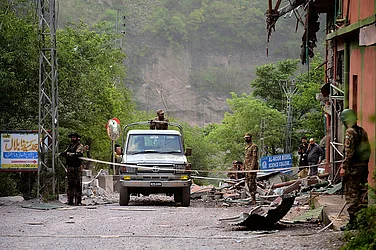Tensions between India and Pakistan escalated into a late night lethal fireworks on the intervening night of Tuesday and Wednesday as India directed missile fire at nine targets in Pakistan and Pakistan-Occupied Jammu and Kashmir (PoK), without crossing the LOC. The world라이브 바카라 eyes are now focused on the Indian response to the terrorist attack that claimed 26 lives in Pahalgam, Kashmir, barely two weeks ago.
India struck at what it said were identified “terrorist infrastructure” in the wee hours of May 7, primarily using the Storm Shadow missile―a sleek deep-strike weapon with a Franco-British pedigree that harmonises with India라이브 바카라 newly-acquired French Dassault라이브 바카라 Rafale fighter jets. It also deployed the French high-tech multinational Safran Electronics & Defense라이브 바카라 munition (bomb) AASM HAMMER. AASM stands for modular air-to-ground weapon.
What is SCALP missile?
The Storm Shadow, also known as SCALP-EG in Europe―a French acronym that translates as Long-Range Autonomous Cruise Missile―was developed by French-British MBDA, and made operational in 2017 after a five-year period of testing. It falls in a class of missiles that are preset to hit an identified target, with no control once they are set off. However, it is capable of avoiding collateral damage instead of hitting inaccurate targets.
Another country that has a supply of Storm Shadow is Ukraine, which is engaged in a battle with Russia for over two years.
India has not officially acquired Storm Shadows, but the Rafale fighter jets are equipped with them, of which India purchased 36 in 2016, with deliveries beginning in late 2019. The Storm Shadow is a conventionally armed missile, capable of striking deep into enemy territory, which flies low, “hugging” the terrain, as a strategy to avoid detection by radar.
The missile has been used in conflicts in Iraq, Syria and Libya. It weighs 1,300 kg, is just over 5 metres long, and has a range in excess of 250 km, according to an MBDA factsheet for the missile.
Storm Shadow can be operated round-the-clock and in all-weather conditions. They have three detonation options―airburst, impact and penetrative, which means they can deliver precision strikes on military and non-military infrastructure. It can easily be deployed against fixed targets, making it the ideal choice for India at this time.
At this time, India has specified that it did not target or strike any military installation in Pakistan, but only sites it had identified as hosting “terrorist infrastructure”. On the one hand, the Storm Shadow missile, fired from the air by Rafale jets, uses a sophisticated imaging system to first record the target, and then identify it at a pinpointed, pre-programmed location. On the other, the HAMMER air-to-ground munition is a different kind of advanced precision-guided bomb. It is known to be highly resistant to jamming, and has a range of around 70 km. This munition can navigate over rough terrain, which could explain why India picked it―along with the Storm Shadow―to strike the Jaish-e-Mohammed and Lashkar hideouts, among other targets in Pakistan and PoK.
What is HAMMER missile?
In February this year, Safran and BEL (Bharat Electronics Limited) forged a partnership for manufacturing AASM HAMMER in India, as part of a larger indigenisation project through technology transfers to develop local capability and reduce import dependence in the weapons sector.
On May 5 this year, well in the wake of the tensions since the brutal attack on tourists in Pahalgam, the Indian Army also received fresh supplies of Russian-origin Igla-S shoulder-fired air defence missiles, according to a news report. This is a very short-range air defence system and was reportedly acquired as part of an emergency order. Such emergency and fast-track orders have been par for the course for India in recent times as it seeks to quickly scale up its capabilities on the defence front.
The significance of Igla-S lies in its ability to target drone-based offensives, which are bound to become increasingly commonplace in any wars in the future.India has also signed a multi-billion deal to acquire 26 Rafale-M marine jets for the Indian Navy, to replace its outdated MiG-29 fighter jets. This $7.5 billion deal is said to be the biggest-ever deal between India and France. This deal was signed on April 28 this year, just five days after the terrorist attack on tourists. Deliveries are expected to begin in roughly three years.
The Rafale itself is a powerful aircraft with a close to 11-metre wingspan, 5.3 metre height, and weighing 10 tonnes. The Rafale M is an advanced version of it.
















